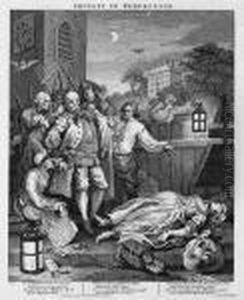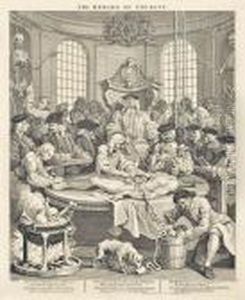





The Four Stages Of Cruelty
-
About Reproduction
Discover the allure of art with our faithful reproduction of "The Four Stages Of Cruelty", originally brought to life by the talented William Hogarth. Unlike posters or prints, our hand-painted oil painting breathes an unique sense of depth and texture into your space. Every detail, every stroke, and every texture is meticulously recreated, paying the perfect homage to William Hogarth and his artistic vision.
Owning this piece is more than just decoration - it's a statement of your refined taste in art. Let the vibrant colors and intricate details of this replica serve as a daily reminder of the beauty in our world. Elevate your decor and appreciate the richness of art with our replica of this masterpiece.
-
Painting Description
"The Four Stages of Cruelty" is a series of four printed engravings created by English artist William Hogarth in 1751. This work is renowned for its stark depiction of the progression of cruelty, from the mistreatment of animals to the eventual degradation of human morals leading to violent criminal behavior. Hogarth, who was known for his satirical and moralistic works, used this series to make a social commentary on the nature of cruelty and the consequences of a lack of empathy and compassion in society.
The series begins with the first stage, "The First Stage of Cruelty," which depicts young boys torturing animals in various ways on the streets of London. This scene is meant to illustrate the early signs of cruelty among children, suggesting that such behavior, if unchecked, can evolve into more severe forms of violence. The second plate, "The Second Stage of Cruelty," shows the same protagonist, now a grown man named Tom Nero, as a coachman who is abusing his horse to the point of death, highlighting the escalation of his cruel tendencies.
In the third engraving, "Cruelty in Perfection," Hogarth portrays the culmination of Nero's brutality as he commits murder, further demonstrating the link Hogarth perceived between animal abuse and human violence. The final plate, "The Reward of Cruelty," serves as a grim conclusion to the narrative, depicting Nero's body being dissected after his execution for murder. This scene is set in an anatomist's theatre, where Hogarth underscores the idea that those who show no respect for life in turn receive none in death.
Hogarth's "The Four Stages of Cruelty" not only serves as a moral lesson on the consequences of cruelty but also reflects the artist's advocacy for social reform and animal welfare. The series was distributed cheaply so that it was accessible to a wide audience, and it is considered an important precursor to later movements for the humane treatment of animals. Today, the engravings are held in various collections, including the British Museum, and continue to be studied for their artistic merit and their powerful message about the human capacity for both cruelty and empathy.
-
Lead Time & Shipping
When you order this oil painting replica, it typically takes 2-3 weeks to paint. If the artwork is more complex, it might need a little more time to ensure the best quality. Once it's ready, we'll send you a photo for your approval. After you give the green light, we'll ship it to you for free.
-
Return & Refund
We believe in the quality of our hand-painted oil painting reproductions, and your satisfaction is our priority. If for any reason, you are not completely satisfied with your purchase, we offer a 45-day return policy. You can return your artwork within 45 days of receipt and receive a full refund. Please note that the artwork must be returned in the original packaging and in the same condition as it was received.




















